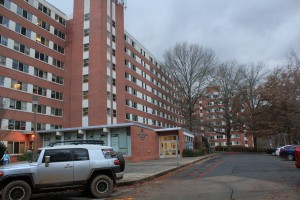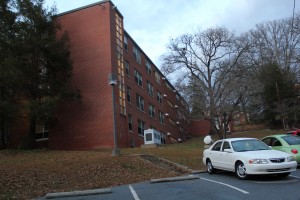There always seems to be someone talking about something.
And for Western Carolina University students, that something is the tuition and fee increases for the next academic year.
Vice Chancellor of Student Affairs Sam Miller, co-chair of the Tuition and Fees Committee, has been instigating that chatter for months now, and it is all culminating into a list of proposals to be sent to the university Board of Trustees. The board will be voting on these proposals before the end of the fall semester and there is a lot of information to process.
It’s safe to say students had questions.
Dr. Miller provided some much needed insight into those questions. And he did so by addressing the increases regarding student housing.
But before we get into that, let’s start with the critics.
I took to the social media hub, Facebook, to get the ranging opinions of the Western Carolina University population.
Senior psychology major James West said he was glad he was graduating this semester because he “would consider dropping out” since the “increases are ridiculous.”
Sophomore elementary education major Jessie Shearin said “we don’t have enough housing as is” and “raising housing needs to only be done when more is built.”
Both viewpoints make a valid point.
But there is so much involved. And that is putting it lightly.
Let’s get down to the nitty gritty.
The Tuition and Fee Committee is looking for a 3 percent increase across the board in residential living fees. In addition, the committee aims to increase the rates for the Walker, Scott, Buchanan, and Albright/Benton residence halls by 5 percent.
The total annual cost including food and housing will increase by about 3 percent overall for in-state students and about a 5 percent increase overall for out-of-state students.
The room rates support the residential living department, which receives no funding from the state of North Carolina. Western Carolina also doesn’t receive any tuition funding. Everything that has to do with the residence hall system is paid for out of the room rates, and all of those expenses are factored in.
There is some discrepancy in the room rates for next year, but the 5 percent increase isn’t all for not. The university is looking to build and expand. And they are going to have to do that from the ground up.
Keith Corzine, the Assistant Vice Chancellor of Campus Services since July, has worked with Dr. Miller on generating the room rate proposals. He has worked at the university in some capacity since 1988 and was the Director of Residential Living from 2002 until his recent promotion.
Corzine, who attended Western Carolina as a student, has seen Cullowhee develop over a long period of time. He has seen what has worked and what hasn’t. Economic downturn has hit the university and the state of North Carolina hard. Cuts are being made and fees are rising, but the tuition and fee proposals are hard decisions that have to be made.
“When we first started building, our rates were either last or next to last in the state. You can’t afford to pay the debt and operating costs on that,” Corzine said. “So, we had to come up with a plan where we knew we would push and maximize rates. We aren’t there yet.”
And it will be a long haul to get to that point.
The Scott and Walker dorms have been two major focal points for the university in coming up with the proposals. The university is planning to make significant changes to those two dorms and eventually even replace them. A replacement project is still a ways off, but for now, short-term renovations are going to have to be made.
The two dorms are increasing from $3,632 to $3,828 per semester starting next year.
In both dorms, the idea is to provide more flexibility within each room. A reconfiguration project in Walker would be to remove the built-in furniture and put in loftable beds. The renovations are seen as opportunities to increase the quality of living for first-year students.
“Our philosophy is the first-year approach. We are committed to it. There is still a great value in the first-year experience in a more traditional way,” Corzine said.
Dr. Miller shared a similar viewpoint.
“Some universities have built apartments on campus. We are never going to do that. We want students to start with us in a traditional residence hall and move off campus and have that apartment living experience.”
The university is growing and hit the 10,000-student milestone this year. And with that, the retention rate and on-campus living have been at its peak.
“We housed 3,922 students at the census date, which is two weeks in to a semester. That is the most students we’ve ever housed on census date in the fall,” Corzine said.
That number speaks volumes to what the university is moving towards. But there is more to be said and more to be done. That is the key here. More!
Since 2004, over half of the 4,000 beds on campus have been built or renovated. Unfortunately, with those improvements, room rates continue to increase and students continue to pay the price. Western has a practically unbeatable location, but with that market comes higher prices.
The cost estimates of Balsam/Blue Ridge and Harrell are higher than the university initially intended, and paying off those costs –- electrical, water, fuel, staff health insurance and retirement benefits, and energy efficiency projects — isn’t a one-step process. There are so many factors in play and nothing is coming easy.
“I think what’s interesting to keep in mind is that Western went 30 years without doing any major renovations or construction projects on [Scott and Walker],” Miller said. “It’s important that we finish that other half. Going 30 years without any major project really put us behind on upgrading what’s available housing wise.”
Dr. Miller elaborated with a more comical approach.
“Scott has been such a great building for Western and has been here for so many years. Anything we can do to keep the old girl in service. Mary Scott has been very good to Western Carolina and we’re going to have to do some work on it. We are also trying to plan ahead in the next ten years, and I hope we have a pretty good plan to replace Scott and Walker.”
All jokes aside, Dr. Miller knows that Scott and Walker are a package deal. The two dorms are very close together and taking one down means bringing the other one down as well. The two contain about 1,200 to 1,300 bed for first-year students.
Making up for lost time isn’t something Western can do at this point, but extensive campus-wide housing changes are in the works.
And upper-campus isn’t going to be left out.
Albright/Benton , which hasn’t been renovated since the 1990s, won’t experience too many changes initially. The university is looking at a connector building and a lobby that would be bigger and more enhanced.
Buchanan has more of the attention of the university and will experience more of a facelift. Notably, it houses freshmen. Dr. Miller said the university wants to utilize Buchanan and an addition to the building could be coming. Rethinking about what the rooms will look like will be important in how everything could shape out.
Long-term and strategic improvements are the main goals in terms of all the housing renovations. Corzine said providing swing space for Scott and Walker will be vital in taking the weight off those buildings. There is even a chance a new community could be built between Buchanan and the Central residence hall to help fill some of the void.
“The biggest freshman class according to our records was back in the 70s -1,800 students after Vietnam War ended,” Dr. Miller said. “The last couple of years have been second, third, fourth largest in our modern times. We’re planning to keep growing, but we want to grow smart. We don’t watch to just throw the doors open.”
And being smart will be the outlier. Western hasn’t been smart about things in the past, but being rational and making the right decisions moving forward will be a must.
“We strive to make sure that its’ an environment for people to feel safe and comfortable and that is welcoming of new and different people and ideas,” Corzine said. “We are trying to promote a community that is a quality example of what people would want it to be.
“If people perceive they don’t want to live there, it only hurts the institution.”
Students will have a hard time agreeing with anything the university does as long as they are dishing out more money.
The beginning of the article showcased that, but here is a different approach.
“I can see why a small increase would be beneficial to helping the campus grow and get better for future students,” said junior criminal justice major Andrew Prusik. “I am not a fan of paying more as money is tight, but I will not complain either.”
Dr. Miller couldn’t have said it any better himself.
“No one likes having to pay more, however we have an obligation to do our best to take care of them for the future and for the students who will be coming to Western. Unfortunately, sometimes that means we have to do increases just to keep up with the rising costs that we’re facing.”
Again, it’s about the progress of the whole over the individual. The university will do everything it can to make things affordable, but their hands are tied.
And with an uphill battle ahead, Western is going to need all the hands it can get.




